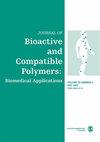以水溶性壳聚糖和氧化透明质酸为基础的双交联水凝胶作为抗菌敷料
IF 2.2
4区 生物学
Q3 BIOTECHNOLOGY & APPLIED MICROBIOLOGY
引用次数: 0
摘要
季铵盐壳聚糖(QCS)是一种具有高抗菌性能的阳离子聚合物,但其阳离子会对正常细胞造成损伤。因此,应关注水凝胶敷料中QCS的生物相容性。本研究以QCS为添加剂,制备羧甲基壳聚糖(CMC)和氧化透明质酸(OHA)水凝胶,并系统考察其含量对水凝胶的抗菌和生物相容性的影响。首先,将QCS与CMC按不同比例混合,形成QCS/CMC溶液。然后,将QCS/CMC溶液加入到OHA溶液中,得到OHA-CMC/QCS水凝胶,该水凝胶是席夫碱与静电相互作用形成的双交联网络。随着水凝胶中QCS含量的增加,水凝胶的力学性能和抗菌性能得到增强。QCS含量为5%的OHA-CMC/QCS5水凝胶对金黄色葡萄球菌的抑菌率达到99.80%,且在实验条件下具有良好的生物相容性。本研究为利用QCS制备具有抗菌和生物相容性的水凝胶提供了理论依据。制备的OHA-CMC/QCS5水凝胶是一种理想的抗菌敷料。本文章由计算机程序翻译,如有差异,请以英文原文为准。
A double cross-linked hydrogel based on water-soluble chitosan and oxidized hyaluronic acid as an antibacterial dressing
Quaternary ammonium chitosan (QCS) is a cationic polymer with high antimicrobial properties, but its cations can cause damage to normal cells. Thus, the biocompatibility of QCS in hydrogel dressings should be concerned. In this study, QCS was used as an additive in the preparation of the carboxymethyl chitosan (CMC) and oxidized hyaluronic acid (OHA) hydrogel, and the effect of its content in the hydrogel on antibacterial and biocompatibility was systematically investigated. First, QCS was mixed at a different ratio with CMC to form a QCS/CMC solution. Then, the QCS/CMC solution was added into the OHA solution to obtain the OHA-CMC/QCS hydrogel, which is a double cross-linked network formed by the Schiff base and electrostatic interaction. With the increase of the QCS content in the hydrogel, its mechanical and antibacterial properties were enhanced. The antibacterial rate of OHA-CMC/QCS5 hydrogel with 5% QCS content against Staphylococcus aureus reached 99.80%, and it also showed biocompatibility under the experimental conditions. This work provides a theoretical basis for the use of QCS to prepare the hydrogels that are both antibacterial and biocompatible. The prepared OHA-CMC/QCS5 hydrogel is an ideal candidate for antimicrobial dressings.
求助全文
通过发布文献求助,成功后即可免费获取论文全文。
去求助
来源期刊

Journal of Bioactive and Compatible Polymers
工程技术-材料科学:生物材料
CiteScore
3.50
自引率
0.00%
发文量
27
审稿时长
2 months
期刊介绍:
The use and importance of biomedical polymers, especially in pharmacology, is growing rapidly. The Journal of Bioactive and Compatible Polymers is a fully peer-reviewed scholarly journal that provides biomedical polymer scientists and researchers with new information on important advances in this field. Examples of specific areas of interest to the journal include: polymeric drugs and drug design; polymeric functionalization and structures related to biological activity or compatibility; natural polymer modification to achieve specific biological activity or compatibility; enzyme modelling by polymers; membranes for biological use; liposome stabilization and cell modeling. This journal is a member of the Committee on Publication Ethics (COPE).
 求助内容:
求助内容: 应助结果提醒方式:
应助结果提醒方式:


